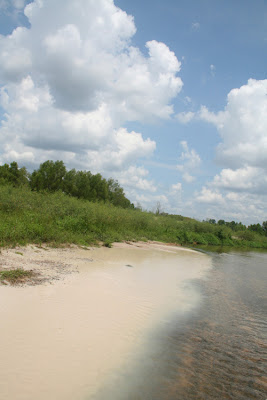 Copyright (c) 2006 Bryan Carlile/Legacy Land Trust
Copyright (c) 2006 Bryan Carlile/Legacy Land Trust
Sand mine on the San Jacinto River, Texas
I had two of my daughter’s teenage friends over here spending the night last night with her, and we were talking about the upcoming election and watching the recent Saturday Night Live skits with Tina Fey and Amy Poehler, and I asked them – since their school is doing a mock election coming up – who they would be voting for. I assumed they’d probably say McCain because I know that both of their parents are Republicans (what can I say – I live in Texas). But when I asked, “Who are you going to vote for?” one of them replied, “Chicken Nugget” and the other replied, “Bob the Builder.”
These are smart kiddos, they are. And witty too. They cracked me up! One of them said they asked their dad for an unbiased explanation of the election but he didn’t give her one. I thought that was pretty smart of her to be able to even recognize that it was not an unbiased explanation! I told her that she can go to CNN.com that has a pretty decent explanation of each candidate’s positions on various issues, and voting records. Heck I figured their school should be giving that information, since they’re having a mock election!! I may just have to have a talk with their teachers.
I’ve been working on a talk I'm giving next Thursday at their school about the San Jacinto River and the impact of sand mining. I am the Founder of San Jacinto Conservation Coalition, a nonprofit organization that co-nominated the river as an American Rivers Most Endangered River, and it was selected as one of ten in 2006. Sand mining devastates both the east and west forks of the river, which is a historical and ecological treasure. The infamous battle cry, “Remember the Alamo” was cried out on the banks of the San Jacinto. And the river is lined with bottomland hardwood forest, which provides habitat for nesting bald eagles, migratory songbirds, and many other wildlife species.
The sand mining is so horrendous that Harris County Precinct 4’s Dennis Johnston told me:
“Sand pits from the air are 10 times worse than what they look like on the ground. They totally dominate the landscape along the San Jacinto River. It looks like nuclear war was practiced in this theatre. The silt drainage they were pumping into the river was so obvious that it looked like cream running into a fresh poured cup of tea.”

This must be the same one that Dennis saw from the air, because this looks like exactly what he described - cream being poured into a cup of tea. The tan color on the left is where the sediment is pouring into the river and on the right is how the river looked upstream of this - absolutely so clear that you could see the bottom. You could see fish. I wrote about this in my article Many Rivers, One Bayou.
It was my first time flying in a Cessna and it was amazing! But the sand mines were a disgrace. The sad thing is that in Texas there are no laws requiring reclamation for sand mines unlike other types of mines. So after they cut down all the forests and destroy all the wetlands, they leave a gaping sand pit, sometimes hundreds of acres large. Forever. It never regrows with vegetation because all the topsoil is gone. And because the sand is right on the edge of the river, all the sand leaches into the river filing it in which exacerbates flooding and causes water quality problems.
The problem with the dumping of sediment (specifically they dump the fine talc-like waste that they can't use) into the river is that it clogs up fish gills and kills them, and it smothers benthic organisms that live on the river floor such as our already disappearing freshwater mussels, and other aquatic life. It does not have to be this way because in other states, there are some amazing reclamation efforts - not to mention sand mining industries that are regulated in the first place! In other states, old sand mines have been turned into lakes or nature preserves. I wrote an article for CLEANHouston on Sustainable Solutions to the sand mining issue that links to some examples. The first article for CLEANHouston was called Muddy Waters.
The fishing is far worse in Lake Houston than in Lake Conroe as a result – you get different fish species altogether, and a less healthy aquatic ecosystem. I wrote an article on sand mining for Texas Parks & Wildlife magazine, Many Bayous, One River, which is one of the articles I’m most proud of – especially because after that article was written a Texas Senator introduced legislation to help prevent sand mining on the San Jacinto (SB359). It passed the Texas Senate, and made it out of the House Natural Resources Committee but they ended up not voting on it because they ran out of time. I’m hoping they will reintroduce it this upcoming legislative session. Apparently November is the time for Congress-people to put bills in the hopper.
In the Appalachians, mountaintop coal mining has received a ton of attention and media coverage but so far no one but me has written about sand mining!! And I’ve had a hard time getting national media interested in the topic. I may try to do a documentary on sand mining. Texas agencies (not to mention the Galveston District of the Army Corps of Engineers) engage in some questionable practices when it comes to the situation. Sand is big money. Sand and gravel brings in millions annually to Texas, which feeds a $20 billion dollar transportation industry.
The problem is not that we need to put a stop to sand mining altogether, but it needs to happen in a river or stream away from a major metropolitan area, because the illegal dumping – and the devastation of the forests around the river and lake – end up costing taxpayers money. Just like we taxpayers are bailing our greedy companies on Wall Street, taxpayers in Texas pay for the illegal activities – and even the legal ones – of the sand mines along the river. The river gets "filled in" from excess sediment and taxpayers foot the bill for any dredging of the river and lake.
But there's something far more serious. Treating the drinking water from Lake Houston is so costly (3 times that to treat the other water treatment plants-$600/MG vs $200/MG; Region H Water Planning Meeting, Mike Turco) because of the excess sediment that the City of Houston expressed interest in getting that legislation passed. They know the link between sediment and blooms of algae and cyanobacteria – which kill fish and cause odor and taste problems in drinking water. The photo below, which I've titled schmung, is a pea green bloom of yukness that was in the river just downstream of the sediment dumping.
Turns out, those very blooms may be toxic and cause long-term neurological disease. Research by top-notch scientists Paul Cox, Oliver Sacks and Sandra Banack of the Institute for Ethnomedicine has recently linked cyanobacteria and the associated toxin BMAA to neurodegenerative diseases, including Parkinson's, Lou Gherig's (ALS) and Alzheimer's. These studies have been published in journals such as Science, PNAS, and Neurology. See the Honolulu Star Bulletin newspaper article for a general interest piece, Water-scum toxin linked to nerve ailments. 
Write to Senator Tommy Williams, District 4, who sponsored the bill last session (tommy.williams@senate.state.tx.us), and represents Harris County and ask him to reintroduce the legislation, and tell of your support for the bill. You can read the full text of the previous version at the link above to SB359. It sets up a "pilot project" on the San Jac that is similar to the one they have on the John Graves Scenic Waterway segment of the Brazos River, where they limited sand mining due to efforts by Walmart heiress Alice Walton.








No comments:
Post a Comment